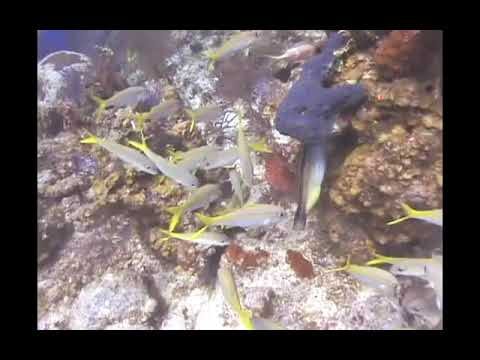One fish, two fish, yellow fish, blue fish
Today’s special animal friend is the Yellow Goatfish, Mulloidichthys martinicus. A medium-sized fish, up to 15 inches long, the yellow goatfish can be found near the Atlantic and Indian Ocean coasts of Africa and also in the Pacific in different places. It’s not entirely yellow: its body is mostly silver, with yellow dorsal fins, a yellow tail, and yellow stripes on the sides.
Yellow goatfish have chemosensory barbels (like catfish) which they use to stir up the sea floor or reef surfaces to scare up food. They eat smaller fish, and they often hunt in schools, sometimes in conjunction with striped sea kraits, as we learned recently.
There is also an aquarium fish called the yellow goat fish, but that is Parupeneus cyclostomus. It is entirely yellow.
Today’s other special animal friend, who also hunts with sea kraits, is the bluefin trevally, Caranx melampygus. A member of the jack family, Carangidae, it is found in tropical and subtropical waters of the Pacific and Indian Oceans. The bluefin trevally is usually around three feet long, but they can reach nearly four feet and over 90 lbs.
Bluefin trevally are also known as bluefin jack, bluefin kingfish, bluefinned crevalle, blue ulua, omilu, and spotted trevally. “Blue ulua” is my favorite of these options. Their tail fins are quite distinctly blue. They are a predatory, schooling species, eating many species of smaller fish as well as crustaceans and cephalopods. They reproduce very rapidly, spawning up to eight times per year and producing up to six million eggs.
They are widely fished commercially and for sport. Overfishing in some areas has motivated farming activity. Here’s some fishing:
The yellow goatfish and the bluefin trevally are both species of Least Concern.



Good morning from The Villages, FL. I'm about to go down to the lobby for breakfast. DQ is still asleep.
Every time a TSAF does an ocean thing, I lament I didn't pursue marine biology.